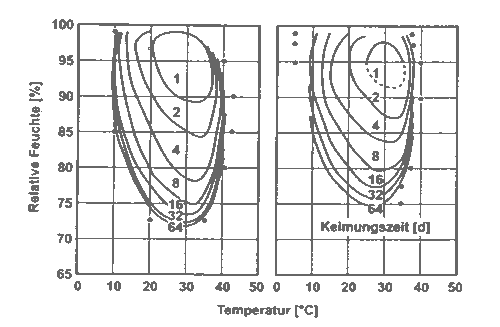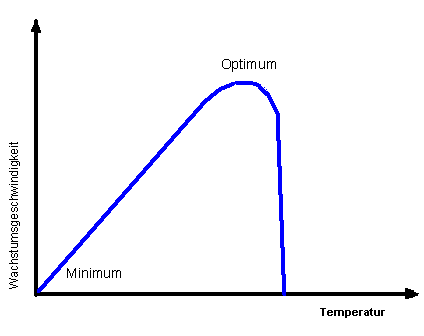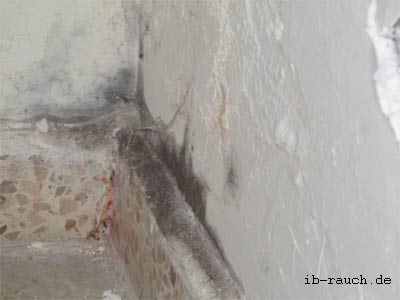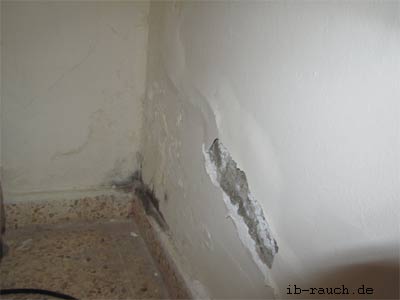Mould in the home - health risks


In order to avoid mould formation, the following selected conditions must be fulfilled:
- Sufficiently thick heat-storing and insulating mineral masonry with a layer structure that is open to division and capillary-conducting.
- Inexpensive energy offers, so that inhabited rooms are sufficiently tempered. 3)
- The planning of the heating of the rooms has to be done mainly by radiant heating.
- A ventilation independent of the ventilation behaviour of the occupants.
- The internal space-enclosing surfaces must be made of mineral building materials with high adsorption capacity.
- The room volume straight line of the bedroom must be of sufficient size. (Usually the bedrooms have the size of a storage room, although these rooms are used for the longest time. Here our body recovers and must not be contaminated with harmful substances!!!)
According to the German Tenants' Association, more than 3.5 million apartments in Germany have already been affected by mould. A result of the large-scale field tests with the local population. The climate and energy policy of the Federal Government leads to poor building constructions in terms of building physics and to the residents' compulsion to save money. Beneficiaries are the insulation industry and the health industry. You can read what insulation really does in the article "Are we insulating the houses or the insulation?" The pharmaceutical industry can also sell pills to the diseased population.
Important causes for the increase in the concentration of moulds and pollutants in the indoor air of the apartments are the reduction of the air exchange (tight windows), lower room temperatures (energy saving), wrong building materials or wall coatings and too small room volumes, especially in the bedrooms. See statistics on mould damage.
With same use of the dwelling however with lower room temperature the relative air humidity increases. This can quickly lead to mould stains on the wallpaper. Cold wall surfaces are particularly affected, such as in the bedroom via the floor on the outside wall. A correct fight against the mould fungi is not carried out with mould sprays and mould paints, but only by eliminating the causes. If one does not know the causes of the development of mould, mould will always remain a loyal roommate of the apartments!
1. Introduction to moulds
Mold is the trivial term for macroscopically recognizable mostly cotton wool-like mycelia and conidia carriers. Fungi that form mold cannot be systematically confined. They belong to different groups. Various structures and appearances are associated with the term mold, for example black mold and green mold, red bread mold, noble mold, watering can mold, brush mold, head mold and others. In addition, many are also called molds, such as blue mold, gray mold, snow mold, and so on [1] ...
Moulds are ubiquitous, i.e. these types of fungi are omnipresent. However, they can lead to health problems in humans if there is a constantly higher concentration in the room air. If mould contamination occurs in living spaces, many residents often suffer from burning eyes, headaches or cold symptoms. If the immune system is weakened, prolonged inhalation of mould spores can lead to allergies. This physical defence reaction can lead to bronchial asthma and cause other health problems in the respiratory organs. [6]
The moulds belong to the microorganisms. In this collective term, many different groups of microorganisms, such as bacteria, yeasts, actinomycetes, algae, fungi and protozoa are summarized. An allocation into the flora or fauna is possible. Algae, bacteria, actinomycetes and fungi are assigned to the realm of plants, especially microflora; only the algae are clearly plants. This is noticeable among other things by the cellulose-like cell wall and the chlorophyll for energy production with photosynthesis.
The animal properties of bacteria, actinomycetes and fungi include the predominantly chemoheterotrophic lifestyle and the formation of glycogen, a starch-like polysaccharide also known as animal starch. Nevertheless, the cell structure does not allow the assignment to the fauna and an exception is the protozoa, which clearly belong to the animal kingdom. [7]
In Germany there are still no binding assessment criteria for indoor mould contamination. The proof of the load of molds serves different goals, belonging to it:
- the proof of an outside air source,
- the detection of an indoor air source or a
- health assessment of the exposure to mould.
Of the approximately 100,000 types of mould, about 30 have allergens. Their function in nature is to break down organic matter and make it available to plants as a source of nutrients in the form of soil. [2] Humans are therefore adapted to the occurrence of mould in their environment and show a high resistance. It reacts consequently only rarely with illness-symptoms to a mold-exposure.
Small mould stains on the wallpaper on a cool outer wall surface do not mean that there is a high mould exposure in the room. On the other hand, in summer, when the air is muggy and warm, the exposure to mould in the home is usually high. The mould is not visually recognisable anywhere in the room.
Decisive for the effect of moulds inhaled is the constitution, the pathogenicity, the total number of acting fungi and the frequency. The strain on people and their exposure are essentially the same for outdoor and indoor sources. [5]
However, a distinction must also be made as to whether the room with the mould contamination is permanently inhabited or only entered occasionally. For example, a storeroom is not inhabited. Optically thin layers of mould on surfaces can occur after a major renovation or after new construction. The high air humidity is caused by the technologically induced setting processes of the building materials. These are short-term appearances of the mold-formation.
In the past, a sufficiently long drying time (wintering or living dry) was observed. A technologically conditioned drying time of the binding agents (cement, lime or gypsum) takes about 2 years, depending on the construction. The exchange of humid air is strongly hindered by tight windows and also by the sarking membrane in the attic. One can only speak of a deficiency if it is caused by a bad construction or the wrong building material. This is not the case if the apartment is being renovated. The only thing that helps here is intensive ventilation and heating.
A mould determination is then useful for clarifying specific issues,
- if there is a serious illness of the residents and the causes of the illnesses such as allergy or respiratory diseases are unknown,
- valuable cultural property is/are damaged, or
- to determine the source if it cannot be determined beyond doubt.
The actual damage can only be solved by changing the causes. These are physical and/or specific properties of the building materials and, of course, the usage behaviour.
2.1 Characteristics of moulds and their metabolic products
Moulds are all fungi which have predominantly morphological but also a number of ecological similarities.
They are characterised by the fact that they have a cotton wool-like, filamentous or powdery (mouldy) appearance on the surface. This is caused by the fact that growth takes place not only inside the material but also on the surface. However, there are also bacteria that show a fungus-like appearance when growing. These include the so-called ray fungi or actinomycetes.
One can emphasize for the characterization of the molds:
Aspergillus and Penicillium (picture 2.1.1.) are the most widespread molds. They belong to the division Eumycota (real fungi), class Ascomycetes (hose fungus), subclass Euascomycetidae, order Eurotiales, family Eurotiaceae. All of them are saprotrophs, i.e. fungi that feed on dead, dead or artificially synthesized organic substrates, for example on food such as bread, fruits, milk, etc. The fungi develop a very typical real mycelium, which is richly branched and spreads in the substrate or on its surface.

Picture: Penicillium (brush mould) [8]
They reproduce almost exclusively by asexual mitospores (anamorphic fructification), by the formation of endospores (sporangiospores) or exospores (conidia), sometimes chlamydospores. The conidia carriers are each quite typically shaped and offer the most important distinguishing features. Thus, in Aspergillus, the conidia-forming hyphae end in a bladder, which is intensively covered with rod-shaped unicellular organs and is called sterigma. The conidia carriers of Penicillium branch out at the tip into thin branches. Each of these branches carries a sterigma, which is crowned by a chain of conidia. The mycelium is more or less colorless. The conidia carry dyes which give the fungal colony its specific colouring, black, brown, green, yellow or white in the case of Aspergillus and mainly blue-green in the case of Penicillium (also green mould). In Aspergillus, the colouring depends on trace elements in the substrate found. For example, Aspergillus nieger turns intensely black (also black mould) if copper is present, otherwise it takes on a light yellow colouring.[9]
As reproduction is almost exclusively through the above mentioned conidia, no conspicuous fruiting bodies are produced. If sexual reproductive organs are formed at all, then only tiny little ones.
Cell sprouting and formation of shoot cells, as characterized by yeasts or yeast-like fungi, occurs only in very rare cases under certain conditions.
Their habitat is preferably the ground, but they are also able to conquer other habitats, such as humid rooms or climate zones.[13]
The characteristically volatile metabolic products of moulds MVOC (Microbial Volatile Organic Compounds) include compounds with boiling points of 0 - 250 ºC and can be assigned to a wide range of different chemical substance classes, such as alkanols, alkenols, ketones, terpenes, aldehydes, alkanes, sulphur-containing compounds, ethenes, esters, carboxylic acids and others. a. Until the year 2001, approx. 30 such compounds were detected indoors and in the outside air, which can be formed by moulds. [14]
The musty smell is often due to the formation of MVOCs by mould or bacteria. The following spectrum of compounds is characteristic:
3-methylfuran, geosmin, 1-octen-3-ol, 3-methyl-1-butanol, 2-pentanol, 2-hexanone, 2-heptanone, 3-octanone and dimethyl disulfide. [14] At higher concentrations, some MVOCs have a toxic effect. Indoors, low levels are usually present that do not contribute to any health risk. The significance of MVOCs has not yet been sufficiently researched. [15] It should also be noted that not all volatile metabolic products produced by microorganisms are of microbial origin. They are also produced by plants and are components of flavourings and technical solvents.
2.2. Food and living conditions of moulds
Fungi are chlorophyll-free organisms. The fungi feed mainly heterotrophically - on organic substances of living and dead organisms. [17]
The essential conditions for growth are closely linked to the presence of water, which is needed for the synthesis of cell material and for the energy production of the nutrients dissolved in the water. [16] In our natural environment, growth takes place when there is a certain temperature, a sufficiently high relative humidity and the presence of the necessary food substrates over a certain period of time.
If these conditions change, growth is restricted; if they improve again, even apparently dead mycelium can germinate anew even after months [18] For this reason, combating mould does not lead to long-term success if the cause is not eliminated.
Good living conditions for mould infestation are also present at a pH value of between 2 and 6.5 also up to 8 and a temperature of 0 °C to +40°C. Moulds generally prefer culture media with low pH values, whereas bacteria prefer a neutral to alkaline range. Most organisms grow in a pH range between 6-8 and are called neutrophil. The growth rate of a cell depends on the pH value of the surrounding medium. In addition, the metabolic process, the cell morphology, the composition of the cell wall and cell envelope and other factors can also influence the growth rate. [19] If the pH-value changes abruptly, usually a change of the pH-value from 1 to 2 is sufficient (even for a short period of time), the growth phase (exponential or stationary phase) can very quickly turn into a dying phase. In fermentation operations (technical production of microorganisms) this case is called a pH shock. In a building the pH-values can also change. In the past, this was done by regularly applying lime paint. However, this is also achieved with the building materials lime plaster or silicate boards.
The redox potential of the nutrient solution is also important. Moulds do not make any special demands on the composition of the atmosphere if they are within the usual climatic range.
Nutritive media for the moulds must be available:
- Carbohydrates as carbon - and energy source as well as main elements
Carbon, atmospheric oxygen, hydrogen, nitrogen, sulphur, phosphorus, potassium, sodium, calcium, magnesium and iron - Trace elements
Manganese, molybdenum, zinc, copper, cobalt, nickel, vanadium, boron, chlorine, selenium, silicon, tungsten and others - Supplements (growth factors)
Amino acids, hormones, vitamins [16]
These culture media are in our natural environment and therefore also in the building. They include, for example, glucose, maltose and sucrose, wallpaper glue, woodchip wallpaper, dispersion paints, wood, paper, textiles, plastics and rubber due to the added softeners, dust, fats and much more. The respective micro-organisms are usually specialized in the degradation of certain substances under certain climatic conditions. Even if the climatic conditions are approximately the same, different concentrations of fungi can occur in the rooms.
For a possible increase of the fungus-concentration, not only the increase of the ambient air-humidity (denser windows and more economical heating use) or the temperature are responsible. The presence of certain culture media also plays a role. The presence of carbohydrates alone is not enough. There must also be certain trace elements cations (for example Co++, Mg++) and anions (for example P, S, N). In contrast, calcium (limestone CaCO3) acts as an inhibitor.
For many microorganisms the nutritional requirements are still unknown. Therefore, no pure or defined compounds are used for cultivation, but complex mixtures such as whey, corn steep liquor or soybean extract. These nutrient media are called complex or undefined. [16]
Today's construction and coating materials and especially synthetic household furnishings (by outgassing solvents or plasticizers) can provide the necessary nutrients that are necessary for an optimal growth process or even inhibit this process. Even older masonry mortars, for example those made from air-lime or marble lime, consist of a variety of chemical additives to improve workability. For example, Acryl2)-Hydrosol (Tiefengrund) is used to improve the properties of the wall surface. But which interactions occur? Even if it is supposed to be solvent-free and therefore does not endanger health from today's point of view. Exactly these mixtures of substances can provide the necessary trace elements and growth factors for the microorganisms.
While 40 years ago, households were almost free of synthetic materials, these have since been transformed into small chemical laboratories, starting with fragrances, toilet cleaners, outgassings from home textiles and furniture to the building envelope.
The interaction of the development of moulds and existing pollutants in the indoor air or on surfaces should therefore be the subject of future research. At present, it is limited predominantly only to the ventilation-behavior.
Synthetic textile fibres that promote mould are not only found indoors, but often also outdoors. Widely spread, these fibres are considered insensitive to moisture. However, this is only true if they have sufficient opportunity to dry between the moisture phases. Awnings often become damp when rolled up in the rain and cannot dry properly in the textile folds. The result is so-called mould stains, which are caused by mould. So-called cassette awnings, which are completely surrounded by a water-protecting cassette when rolled up, offer more protection against such mildew stains. However, here too it is important to ensure that the awning is not rolled up when damp.
Unfortunately, no targeted research into the prevention of mould in residential buildings is expected in the near future, as combating mould has become an attractive side business for the industry. The chairs and institutes of the universities are financed by the economy, and which university teacher risks his safe job only for the truth. The students just learn only the official view and what the economy dictates. More under the contribution to neoliberal building policy.
Influences on the growth of moulds
The temperature influences the metabolism, the nutrient requirements, the biomass composition of the cell and above all the growth rate of the microorganisms. If the temperature is 10-25 °C below the optimum temperature, the transport processes slow down and the growth rate moves towards zero. In contrast, a temperature increase in the optimum range causes a disproportionate increase in the growth rate. In practice this becomes clear why in a building with approximately same relative humidity and utilization-behavior in 5 apartments no and in an apartment mold attack is determined. Here temperature differences of 2-3 K can be present. This fact is also considered in the following isopleth system. (Detailed explanation in the mold book.)
Picture: Isoplethene systems for spore germination of molds (Aspergillus restrictus (left) and Aspergillus versicolor (right).[25]

Picture: Isoplethene systems for spore germination of molds (Aspergillus restrictus (left) and Aspergillus versicolor (right).

Explanation of the growth curve:
Minimum jelly-like membrane, slow transport process
Optimum maximum speed of the enzymatic reaction
Maximum protein denaturation, cytoplasmic membrane breakdown, thermal lysis
With regard to their requirements for optimal temperature conditions, microorganisms behave very differently. One distinguishes the molds according to its optimal growth-temperatures, mesophilic molds with 25-35ºC, thermotolerante molds with 30-40ºC and thermophilic molds with 35-55ºC (max. approx. 60ºC) [22] the division with the psychrophilic organisms (under 0ºC to 20ºC) is to be completed. To this, marine bacteria and iron bacteria belong predominantly. Thermophilic bacteria reach their limit at 70ºC and extremely thermophilic organisms between 80-90ºC (for example genera Bacillus and Clostridium), bacteria that grow above 90 and 100ºC are called hyperthermophilic organisms. [23]
The interaction between humidity, temperature and food substance are shown in the isopleth system for spore germination of moulds. Detailed information in the mould book.


These moulds are located in the outer wall of a permanently used room about 1 m below the ground surface of a hotel complex in Tunisia. The temperature of the room air on 01.03.2016 is 20.4°C and a relative humidity of 46%. The surface temperature is 18.7°C. That would be about a relative humidity at the wall surface of 50%. The relative air humidity during the winter time is mostly below 60 %. There are also no large temperature fluctuations. The salt efflorescence on the cement plaster is clearly visible. The salts are strongly hydroscopic. The cement plaster also forms a barrier layer. The moisture from the air is bound by the salt, but it cannot escape through a pore structure either.
There is almost no rising dampness here, as there is very little rainfall throughout the year and the water table is many metres deep. There is also no downpipe or other water-carrying pipes that could be broken. There are no salt deposits or mould on other parts of the wall on this floor. The cause is therefore the wall salt, the blocking effect of the plaster and the constructive peculiarity of exactly this wall section. The cause in this case is not too high humidity or inadequate ventilation.
1)
Prevention is the term used to describe measures to avert undesirable conditions that may occur if no suitable measures are taken. These are therefore measures which are aimed at the effect.
2)The current energy policy is also intended to encourage energy saving, but on the other hand causes a sick population.
3)Term for plastics consisting of polymerized compounds of acrylic acid and/or methacrylic acid. Acrylic acid is the simplest unsaturated carboxylic acid.
Literature sources
[1] Dörfelt, Heinrich, BI-Lexikon Mykologie Pilzkunde, 1988, VEB Bibliographisches Institut Leipzig, S. 344
[2] Davis, P.,J: Molds, Toxic Molds, and Indoor Air Quality, California Research Bureau, California State Library CRB Note., 8, (1), 1-17 (2001)
[5] Schimmelpilze in Innenräumen - Nachweis, Bewertung, Qualitätsmanagement, 14.12.2001; Abgestimmtes Arbeitsergebnis des Arbeitskreises "Qualitätssicherung - Schimmelpilze in Innenräumen" am Landesgesundheitsamt Baden-Württemberg, Dr. Gabrio, Wiederholdstr. 15, 70174 Stuttgart, gabrio@lga.bwl.de, S. 16
[6] biomass Ingenieurbüro mbH, Herzbroicher Weg 49, 41352 K.; (www.biomess.de/Inhalt/Detailinfos/Schimmelpilze/Pilzarten/hauptteil_pilzarten.htm)
[7] Glathe, H.; Farkasdi, G.: Morphologie der Rotteorganismen. In Häsel, G.; Schenkel, W.; Schnurer, H.: Müll-Handbuch, Kennzahl 5020, Lieferung 7/65, Erich Schmidt Verlag, Berlin
[8] Boedijn, K. B.; Knauers Pflanzenreich in Farben, a.a.O., S. 144
[9] Boedijn, K. B.; Knauers Pflanzenreich in Farben, a.a.O., S.108-109
[13] Schwantes, H.-O.; Biologie der Pilze 1995, Stuttgart Ulm 1996, S. 230-235, 250
[14] Schimmelpilze in Innenräumen - Nachweis, Bewertung, a.a.O., S. 14
[15] Schimmelpilze in Innenräumen - Nachweis, Bewertung, a.a.O., S. 23
[16] Schwister, Karl u.a.; Taschenbuch der Verfahrenstechnik Fachbuchverlag Leipzig im Carl Hanser Verlag 2000 S. 438-440
[17] Zachäus, D.; Biologische Abfallbehandlung, Karl J. Thom copy; Enzyklopädie S. 215; in DB 1995 Te 13707
[18] Rauch, Peter: Schimmelpilzbildung infolge Wärmebrückenbildung - Allgemeine Darstellung und Aufzeigen konstruktiver Mängel beim Dachgeschoßausbau, Vortrag 4.5.1994 Bauberatungszentrum Leipzig
[19] Schwister, Karl u.a.; a.a.O., S. 443
[22] Mück, M.; Lehmann, Ch.; Schimmelpilze, Vorkommen, Gesundheitsgefahren, Schutzmaßnahmen, ecomed-Verlagsgesellschaft, Landsberg 1999
[23] Schwister, Karl u.a.; a.a.O. S. 441-442
[25] Smith, S.L.; Hill, S. T.: Influence of temperature and water activity on germination and growth of Aspergillus restrictus and Aspergillus versicolor. Transoctions of Brtish Mycological Society Vol. 79 (1982), H. 3, S. 558 - 560
© Altbausanierung | Bauideen | Blog | Sanierungskosten | Impressum | AGB/Datenschutzerklärung | 5/2013 ![]()
